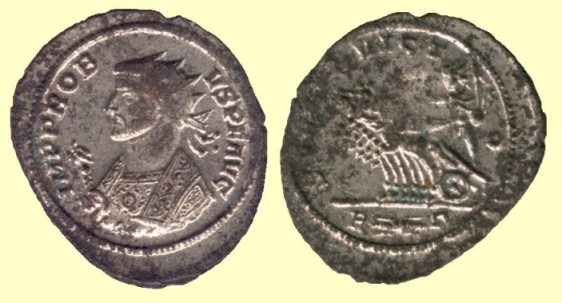Sol / Sol Invictvs
The sun has been revered as a deity by ancient civilizations all over the world. When man became a farmer, and thus dependent upon daily and seasonal changes of the weather, he turned to worship the great force that regulated these changes, the light and heat of the sun. Not only as a beneficial force, in hot countries people also feared his destructive powers. In ancient Egypt the sun god Ra was represented by a man bearing a sun-disc on his head, which was surmounted by the Uraeus-snake. The reptile symbolized the withering effect of the sun. Quite different was the situation in Central and Northern Europe, where a sufficient amount of sunshine was essential for the ripening of crops. Here the sun was worshipped as a beneficial power.
In Roman society the sun was worshipped in many forms. They adopted the Greek sun-god Helios who rode a chariot drawn by horses through the sky, bringing light to the earth. The journey of the Sun, naturally, began in the East and ended in the West, at which point Helios completed his daily rounds and floated back to his Eastern palace in a golden cup. Helios' Roman name was Sol and he was worshipped as Sol Indiges (the Native Sun). Nero often styled himself as Helios. Another sun-god worshipped by the Romans was Apollo, he wasn't solely a sun-god but aspects of the sun where attributed to him. According to Livy, the first Roman Shrine of Apollo (AEDES APOLLONIS) was consecrated in 431 BC in the Prata Flaminia. The site had already been a sacred enclosure or grove associated with the God. Augustus had a temple dedicated to the solar Apollo on the Palentine. The Circus Maximus housed a temple dedicated to Sol, as a chariot riding deity he was worshipped by the charioteers.
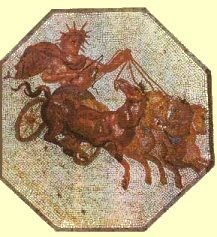
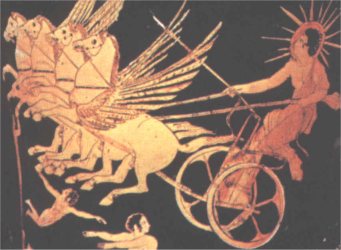
Around the second century AD Mithraism, an eastern variant of sun worship, became quite popular among the Romans (only men since women weren't allowed in this solar mystery cult). Mithras isn't Sol himself but he is invested with the powers of the sun by Sol himself. Mithras was born of the Earth in the shade of a sacred tree beside a sacred stream holding a knife and a torch. He received word via a Raven from the Sun god that he was to slay the mystic white bull. Upon slaying the bull, the bull became the moon, and Mithras' cape became the sky. Day and night began to alternate, animals and plants were created, the seasons began to change, and time was created. Along with all of this, the battle between good and evil, of which man is a part, began. At this point, Mithras climbed into the Sun god's chariot and began to ride it across the sky. New in this eastern variant of the Sun god was the constant struggle between good and evil and the fact that followers had to live their lives by a moral code. The main recruits were soldiers and merchants, probably two of the most superstitious classes in society. Under the Severans this eastern variant of Sol was given a much more prominent place in the state religion. Septimus Severus added a radiate solar nimbus (a halo or aura) to his own imperial image and Caracalla started to wear a radiate crown in order to show himself as Sol's manifestation on earth. The radiate crown also became a mark of denomination for a type of coin introduced by Caracalla called an antoninianus (this is a modern name since its not known how this denomination was called in Roman times, it had a value of 2 denarii).
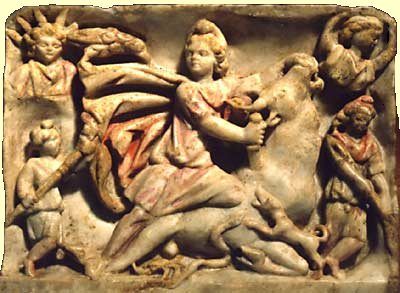
In 219 AD the young emperor Elagabalus tried to establish the cult of SOL INVICTVS Elagabal (Elah Gabal the invincible/unconquerable sun) in Rome as the new and one and only state religion. In Syrian Emesa, the Solar Deity was known by the name Elah Gabal (God of the Mountain) and revered in the image of a sacred black meteor. This icon was brought to Rome by Elagabalus to a newly built temple dedicated to Sol Invictus on the Palatine. The teenage emperor Elagabalus believed Sol Invictvs to be THE supreme deity but the notion of a single supreme deity was still quite alien in Roman religion. His active promotion of the god and making Sol Invictus not only equal but superior to the Roman gods outraged the Roman people and made Elagabalus quite unpopular and he was quickly deposed of. The sacred stone was quietly returned to Emesa and his temple rededicated to Jupiter Ultor by Elagabalus' successor Severus Alexander. However when emperor Aurelian (270-275) came to power, he sought to restore the worship of the Sun to prominence and make him the chief deity. He considered Sol Invictus Elagabal too foreign or Eastern for Roman tastes and so he Romanized it by dropping the Elagabal. In 274, the emperor built a magnificent temple dedicated to Sol Invictus at the Campus Agrippae, and established a new college of senators which he named the Pontifices Dei Solis "priests of the Sun god." He also introduced the 25th of December as the birthday of the Sun god (natalis solis invicti) and made it a public holiday. On the Roman calendar the 25th of December was the day of the winter solstice, the day the sun was born again. The days would start to grow longer again announcing a new season. Mithrians also considered the 25th of December as the birthday of the sun, so this became a very prominent day of sunworship and celebration.
"Sun-day, or the day of the Sun, was the main Roman day of worship. Although other Roman gods had days named after them (the days of the week: Sun, Moon, Mars, Mercury, Jupiter, Venus, Saturn), only "dies solis" ("day of the sun") was proclaimed to be holy. You can already recognize some of our modern weekdays Sunday, Monday and Saturday. In Southern European languages as French, Spanish and Italian the modern names are all extremely similar to the names of the Roman gods. In more northern country's as Holland, Germany and England some Roman Gods where replaced by their Germanic counterpart (Tiu, Woden, Thor, Freyja => Tuesday, Wednesday, Thursday and Friday).
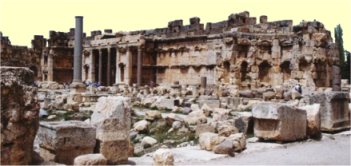
By the end of Aurelians reign, Sol Invictus was hailed as "The Lord of the Roman Empire." and in 307 AD the prominence within the Roman Empire of Sol Invictus was solidified by Diocletian by his public dedication to Sol Invictus, acclaiming him as "protector of the empire." But it was during the rule of Constantine the Great that the cult of Deus Sol Invictus reached extraordinary heights, his reign was even spoken of as a Sun Emperorship. Constantine was the personification of Deus Sol Invictus on earth, and he built a statue of himself with a crown of solar rays and holding a thunderbolt. After his conversion to Christianity on his death bed however the cult of Sol Invictus slowly faded and made way for Christianity. Christianity however did integrate Sunday and the 25th of December (the birthday of the son of God) into their new religion.
Sol Invictvs is usually depicted on coins as a youth wearing a radiate crown and cloak, holding a globe (symbolizing the world) and whip (used to drive the sun chariot). He's often depicted riding a four horse chariot called a quadriga. All these are symbolic of Sol Invictus driving the sun across the sky. Inscriptions include SOL ORIENS (the rising, eastern sun), SOL INVICTVS/INVICTO (the invincible/unconquerable sun), SOLI INVICTO COMITI (committed to the invincible sun).
